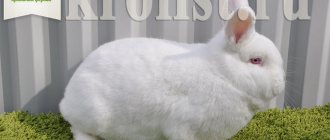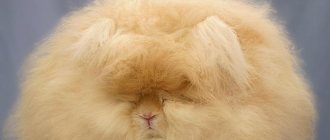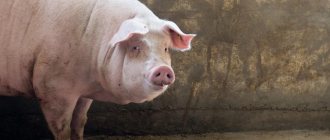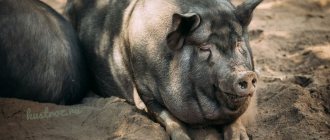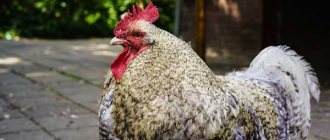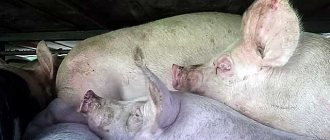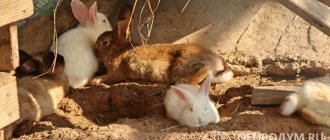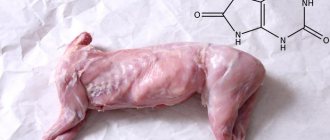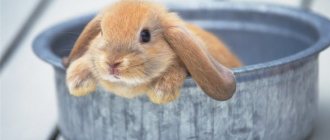Breeders of cute and fluffy animals should have reliable information about how much a rabbit weighs and when the animal gains the most weight. Such information will help determine the effectiveness of the selected food and the time when the rabbit will produce the largest amount of meat when slaughtered. It is worth noting that each breed of animal has an individual growth rate.
Weight by breed
When choosing a breed, beginning rabbit breeders rely on maximum weight and conditions for weight gain. At the same time, they are studying the influence of various factors on the growth rate of rabbits.
| Breed | Weight, kg |
| Butterfly, Silver | 4-6 |
| Belgian Flanders | 6-12 |
| White giant | 6-8 |
| Blue Royal Giant, Californian, Soviet Chinchilla | 4-5 |
| German giant | 7-9 |
| New Zealand | 4,5-6 |
| Gray giant | 4-7 |
| Soviet Marder | 3-4,5 |
| French ram | 6-7, 5 |
| Black-brown | 5-7 |
A proper diet is the key to health!
I will repeat a common truth, which, however, most rabbit breeders lose sight of: rabbit food must be perfectly balanced. As experienced rabbit breeders say: If you feed only hay, the rabbit will only grow ears. Translating into a more scientific language, I will say that the speed of weight gain and the condition of the gastrointestinal tract of animals depend on the quality and calorie content of food.
Feeding only hay is an extremely low-calorie diet that will support life and healthy intestinal motility. To gain weight, animals need to be fed grain bait, whole grain or crushed grain. In addition, they are given mineral supplements and soft food. Instead of creating a menu manually, it is easier to purchase ready-made feed - a balanced mixture of grains, bone meal and minerals.
A varied diet is the key to the health and rapid growth of a rabbit.
Minerals are especially needed by breeding animals and those breeds that are raised for fur. Grain mixtures containing legumes, corn, sunflower or rapeseed are available for sale. These supplements are high in calories and promote weight gain.
There are foods that are contraindicated for animals:
- fresh grass on which pathogenic bacteria are present, because in 95% of cases, epidemics that can destroy livestock in the territory of an entire village are transmitted precisely through fresh leaves;
- some types of plants containing toxins: foxglove, lily of the valley, henbane, colchicum, lumbago, buttercup and others;
- branches of stone fruit trees and the essential oils they contain are toxic to animals;
- bread crumbs can clog the intestines, which leads to the painful death of animals within 24 hours.
Weight by month
Each animal has its own characteristics and develops individually. By monitoring the growth of rabbits of different breeds, scientists derived average growth rates by month. Animals usually gain maximum weight for slaughter by the 8th month of life, sometimes by a year.
| Breed | Weight, g | |||||||||
| Age, months | 0 | 1 | 2 | 3 | 4 | 5 | 6 | 7 | 8 | |
| Butterfly | 50 | 600 | 1600 | 2400 | 3200 | 3600 | 3900 | 4100 | 4300 | |
| Belgian Flanders | 100 | 800 | 2600 | 3600 | 4700 | 5500 | 6300 | 7000 | ||
| White giant | 70 | 700 | 2300 | 3400 | 3800 | 4200 | 4600 | 5000 | ||
| Blue Royal Giant | 600 | 2100 | 2900 | 3200 | 3600 | 4000 | 4200 | |||
| Californian | 50 | 500 | 1500 | 2700 | 3100 | 3500 | 3800 | 4100 | 4300 | |
| German giant | 900 | 1200 | 3200 | 4800 | 6400 | 7100 | 7800 | 8500 | 9000 | |
| New Zealand | 60 | 600 | 1600 | 2500 | 3200 | 3500 | 3800 | 4100 | 4300 | |
| Silver | 500 | 1500 | 2200 | 3100 | 3700 | 4200 | 4700 | 5000 | ||
| Gray giant | 600 | 3000 | 3600 | 4100 | 4600 | 4800 | ||||
| Soviet Marder | 500 | 1400 | 2100 | 2900 | 3200 | 3600 | 4000 | 4200 | ||
| Soviet chinchilla | 600 | 1500 | 2800 | 3100 | 3500 | 4000 | 4300 | 4800 | ||
| French ram | 80 | 1000 | 2400 | 2600 | 3800 | 4300 | 4400 | 5300 | 5500 | |
| Black-brown | 700 | 1600 | 2500 | 3200 | 3600 | 4000 | 4500 | 4800 | ||
Keeping and breeding giants
Caring for giant rabbits has its own specific characteristics. Despite the fact that the vast majority of this species is undemanding in care, successful cultivation still requires compliance with certain rules when choosing an animal, namely:
- You can purchase such species no earlier than they are 5 months old.
- Before purchasing livestock for breeding, you should decide what end result you want to get: luxurious fur or high meat yield.
- In addition, it is necessary to take into account that in professional nurseries the cost of a giant rabbit is indicated per month. In other words, if you are counting on buying a four-month old individual, then the price indicated for it is multiplied by 4.
Caring for giant rabbits is not difficult.
But if we take into account the fact that individuals have a lot of weight, then some steps should still be followed, namely:
- When choosing a cage for an animal, it is better to give preference to a wooden structure. In such a house they can easily withstand severe frosts.
- Aviaries with a mesh floor are not worth purchasing. The fact is that such a floor can damage the rabbit's paws.
- If you plan to design your own animal cage, make it spacious and have a wooden floor.
- In the finished cage, it is necessary to properly equip the area in which the drinking bowl and feeder will be located.
- If your female is expecting offspring soon, do not forget to install a box with low sides for her.
- If the climate where you live is mild, then you can safely keep giants outside. Well, if you have harsh winters, try to create warm conditions for the animals and protect them from drafts.
- In the summer, be careful to ensure that the animals do not overheat. To do this, it is best to move the livestock to a cool barn or basement.
Giant grooming includes regular cleaning of feeders, drinkers and cages. To disinfect drinking bowls and feeders, you need to wash them daily with water and then pour boiling water over them.
2.jpg” alt=”rabbit being fed cookies” width=”580″ height=”400″>
As for the cage, it is cleaned as it becomes dirty; in addition, it is very important to periodically disinfect it. Sanitation is carried out as follows:
- twice a year the cage is cleaned using special preparations or slaked lime;
- This procedure is performed before the female gives birth;
- during epidemics and animal diseases;
- and disinfection using chemicals is also carried out before planting new individuals and before settling young animals.
Well, as for regular cleaning, it is performed as the flooring gets dirty. Typically, flooring is replaced every four days.
Very often, beginning rabbit breeders ask the question of what to feed giant rabbits. This variety is known for having a simply heroic appetite and consuming almost all the food that the rabbit breeder offers.
It is for this reason that feeding should be thought out and balanced in advance.
It is important to understand that a disordered diet will not give a positive result. So, what should be the proper feeding of giants:
- hay;
- special granulated feed;
- green mass, previously dried from moisture;
- seasonal vegetables and fruits;
- mineral supplements;
- branches of fruit trees and bran.
This list of products must be present in the diet of animals. At the same time, they give such food alternately.
And one more important point that should always be monitored is the availability of warm drinking water. Water is very important for rabbits, so make sure there is always water in their drinking bowls.
Jpg” alt=”compound feed in hands” width=”580″ height=”400″>
And the last frequently asked question by beginning rabbit breeders is breeding giant rabbits. Breeding rabbits of this breed is actually not difficult; the process is not much different from conventional breeding. You will need to select a healthy female that is pre-weighed to determine her weight class.
Animals are allowed to begin mating only after the seventh month. To do this, they are placed in a separate enclosure and are not disturbed for several days.
Jpg” alt=”rabbit with babies” width=”580″ height=”400″>
Another point worth considering: giants are gluttons, so if you want to get offspring, try to limit their access to food, otherwise the animals will be busy eating and not procreating.
And the second question: how long does it take for the young to be separated from their mother? In this case, it would be optimal to remove the babies from the female after a month and a half. By this period, the rabbits become independent and quite strong.
Growth characteristics of rabbits
Rabbits are born blind, with 16 baby teeth. After a week, their body is covered with the first fluff; over the course of a month it increases and by the 25th day it becomes full-fledged fur.
On the tenth day of life, they open their eyes, and on the 20th they are able to leave the home and eat food. Milk teeth fall out on the 18th day of life, after 10 days permanent teeth appear.
The period of birth influences the development of newborns. Those born in winter or early spring grow faster, unlike rabbits born in summer or autumn. Babies are born very tiny, weighing 40-100 grams. After a week, their weight doubles, and within a month - 10 times.
This is facilitated by the composition of mother's milk, enriched with nutrients: fats 10-20%, proteins 13-15%, calcium 0.60-0.70%, phosphorus 0.40-0.50%, milk sugar 2%.
Lactating females produce milk abundantly in the summer. The highest rates are for Californian and Soviet chinchillas, the lowest for New Zealand ones.
Until 3-4 months, the growth rate of rabbits is high, then gradually decreases. At this age they become sexually active. They have a very weak spine and limbs that they can easily break. The skeleton is fully formed by the first year of life.
Record holders among long-eared animals
Ralph Rabbit's story is like a roller coaster. Paulina Grand's ward is considered the largest. But doctors are seriously concerned about the pet’s well-being. Today, the weight of the big-eared celebrity is 22 kg, although the owner assures that she provides the rabbit with physical exercise. However, the giant is outwardly active and does not show any dissatisfaction with its maintenance or care. The body length of the playful domestic hare is 130 cm.
Darius is another former Belgian breed record holder. In 2010, he even managed to dislodge Ralph, however, after that he lost ground with a weight of 19 kg. His owner, Annette Edwards, had previously registered large rabbits in the Book of Records; they were the parents of Darius. Apparently, the hereditary factor played a huge role in this particular case. The length of the body in 2010 was inferior to the current leader. True, according to some reports, the pet will soon snatch the palm from Ralph again. The owner claims that the rabbit gained weight 22.2 kg and grew to 130 cm.
Jeff is the son of Darius, so it is not surprising that the whole world expects big victories from him. Annette, as a specialist in breeding ornamental breeds, is confident that Jeff will become a record holder. Now the rabbit is 3 years old, but its body length is already 95 cm. Miss Edwards is happy to tell the secret of such success in an interview. First of all, this is a balanced diet, as well as physical exercise. For example, Darius’s weight, as Annette admits, is largely determined by muscles. He is very active, runs constantly, and his caring owner spends the lion's share of her financial resources on quality maintenance. The price of good food for large breeds is high, which forces the farmer to turn to relatives for help.
What affects weight gain
In addition to genetic data, a properly formed diet is important. It includes different types of feed, vitamins and minerals. Rabbits have a very unique digestive system (food should always be in the gastrointestinal tract), so they are fed in small portions several times a day: 4 times for a nursing rabbit and newborns, for other animals 2-3 times are enough. But there should be hay in the cage all the time. Access to clean drinking water is provided freely.
For the normal functioning of the gastrointestinal tract, it is necessary to adhere to the chosen diet and avoid sudden changes in food. Of the vitamins, special attention should be paid to A, D, C, E, B.
There are special additives - growth stimulants. They not only accelerate weight gain, but also strengthen the immune system and build resistance to diseases. The dose of such a drug is calculated based on the nutritional characteristics and age of the animal.
The growth of rabbits depends on their physical condition. To maintain the health of individuals, they organize comfortable living conditions, adequate care, and maintain high-quality nutrition.
Nutritional supplements for artificial weight gain
To improve appetite, breeders add vitamins to pet food. Beneficial substances of groups A and E are used together with fats, vitamin D is added to thick and porridge-like food. The drink is diluted with vitamin C.
After consultation with a veterinarian, animals are prescribed vitamin-mineral, as well as protein-vitamin-mineral supplements (PVMD).
They strengthen the animals’ bodies with useful microelements: manganese, calcium, phosphorus. Protein-containing options provide protein to the animal's muscles.
Vitamin and protein supplements have no contraindications. The correct dosage is calculated taking into account the body weight and age of the pet. The use of additives above the norm worsens the taste characteristics of rabbit meat.
Sizes: furry giants and babies
During selection, two hundred breeds of animals were bred, and they all differ not only in characteristic habits, color and length of fur, but above all in weight and size.
Breeding standards
The range of values is so wide that all domestic rodents are classified into four main groups:
- Dwarf. For the smallest, dwarf breeds, the standard weight is from 1 kilogram to one and a half. Animals weighing 1.3 kg and measuring no more than 20 cm have an ideal proportion.
- Small ones. The main distinguishing feature of a small ornamental animal from an ordinary meat rabbit is its relatively small weight. An adult rarely exceeds the limit of 2 kilograms with a body length of 25 to 30 cm.
- Average. Rabbits of this group, when growing up, quickly gain weight up to 4 kg, and the length of the body extends to 57 cm.
- Large ones. Real giants, striking the imagination with their accumulated mass. The record weight is 8 kg, and the size of the carcass reaches 70 cm.
Eared giants
Among some breeds, animals of truly outstanding size stand out:
- English fold. The breed is considered the oldest and remains the most popular in England. The weight of an adult giant rabbit reaches 5.5 kg.
- French Fold. At the end of the 19th century, a new breed was obtained by crossing the English and French rabbits, the representatives of which grow up to 6.8 kg.
- Dutch, the weight of the animal reaches 5 kg.
But the real giants are the rodents bred by Soviet breeders in the middle of the last century. Combining the desire to obtain animals with high vitality, precocity and excellent health, scientists crossed the English breed of large animals with local ones, which were distinguished by their large body weight. Thus, scientists obtained giant rabbits with good genetic characteristics:
- Gray giant. The average weight of an adult animal is 4-6 kg, and record-breakers weigh more than 7 kg.
- Soviet chinchilla. The weight of an adult animal reaches 5 kg; for particularly large rabbits it is 7–8 kg.
The leading place in terms of size is occupied by the Belgian Flanders. A long rabbit, growing up to 70 cm, with thick, luxurious fur. Ordinary animals weigh from 7 kg, some grow up to 10-12 kg, and the recorded record is 25 kg.
History of origin
This subspecies of rabbits was bred in 1910 in one of the states of America. Selection experiments were carried out on albino individuals of the New Zealand subspecies of the red breed. Subsequently, breeding of animals was carried out between the best selected individuals. They were selected for early maturity at an early age. The following characteristics were important:
- Volume of meat products;
- High slaughter weight;
- Quality of meat and fur;
- Snow-white shade of wool.
Selected individuals were crossed with the Flanders breed. Selection experiments were required in order to eliminate overdevelopment of body weight and constitution.
By 1958, the subspecies had become widespread. The breed's first popularity came in Europe. At the end of the 90s, the subspecies took first place among the leading breeds. The subspecies was distributed in Great Britain, Germany and Italy.
In the USSR, rabbits of the white subspecies appeared in the early 70s. Individuals easily adapted to the natural conditions of the country. The subspecies has spread throughout all regions. Currently, animals are kept on farms, homesteads and private farms.
Standard indicators
If we talk about average indicators, then the weight of a rabbit should be from 4 to 5 kg, however, in practice, there are cases when record holders with a weight of 8 kg grew up on farms in those breeds that are not characterized by such an indicator. The weight of a two-week-old regular rabbit is no more than 45 grams, but it may be less, depending on the breed.
Table of weight in grams by month.
You need to understand that live weight and slaughter weight are not the same thing and the difference between them is 30%, which includes the skin and internal organs. With a live weight of a rabbit of 5 kilograms, the slaughter yield is only 1.5 kg. If a live rabbit weighs 10 kg, then the carcass is only 7 kg.
Newborn rabbits weigh very little, they are hairless and blind. Month-old offspring feed exclusively on mother's milk; as a result of such a balanced menu, their weight increases 10 times. Despite the fact that the weight no longer increases at this rate, it still continues to grow, and by 5 months the rabbit has gained 70% of its maximum weight. On average, a healthy animal should weigh 3.5 kg by the specified date.
It is worth saying that only large breeds, which are distinguished by record performance, are grown for commercial purposes. They differ from other breeds in that they grow quickly and after only 9 months they are ready for slaughter. An adult rabbit reaches its maximum weight at 10 months.
A newborn rabbit weighs only 62 grams; by 1 month it increases to 800 grams. At 3 months his weight is 2700 g, at 4 months - 3.6 kg and by 6 months - 5.5 kg. The weight gain is 50-60 grams per day.
Meat quality: important factors
These values are an estimate of the meat productivity of various species. The indicators depend on the breed, nutritional status, and the age at which the slaughter was carried out. They will also differ depending on whether it is a female or a male. In low-productive species, the slaughter yield is 50-52%, and those belonging to the meat sector provide this value of 60%.
The fleshiest part is the musculature near the skeleton. It grows faster than other parts of the body. Meat productivity is determined by the early maturity of the breed. This refers to the ability of animals to achieve large body weights at an early age. Animals producing meat and skins gain most intensively from 20 to 120 days after birth. Pure meat breeds give the greatest increase in age from 20 to 90 days.
What factors influence the final weight of a rabbit?
Parameters influencing body weight gain:
- Features of the breed chosen for breeding.
- Good initial feeding with mother's milk.
- Adequate nutrition and ensuring a feeding regime.
- Good health.
- Proper care.
- Comfortable stay.
The breeder regulates the body weight of the wards. If the indicator is insufficient, you should try to observe the behavior of the animals after they are given food. Maybe it will become clear that more aggressive individuals do not allow other inhabitants to approach the feeder. In this case, the fighters need to be put away. The remaining animals should be provided with sufficient food. Another way to gain weight is to limit your mobility.
Breed is not the only important factor that determines how high the quality of rabbit meat will be. Much depends on the food and the conditions in which the animal lived. Currently, China provides the largest volumes of rabbit meat. As experts note, despite the numerous kilograms, raising rabbits for meat in this country leaves much to be desired: the finished product is not very good.
Hungarian manufacturers have a good reputation, supplying environmentally friendly products to the markets of other countries. There is also quite active demand for domestic goods. In our country there are several large and small farms, the owners of which know from their own experience how much an ordinary rabbit weighs and how to fatten it so that the meat is of high quality.
Video
This video will tell you about the best breeds of rabbits.
So, we looked at the characteristics of meat rabbits. As you can see, today there is a choice, and quite a decent one: you can focus on domestic animals, or decide to breed equally attractive foreign specimens. In any case, the meat breed of rabbits will be distinguished by high productivity, rapid growth, decent slaughter yield, in addition, fertility and unpretentiousness: the benefits from breeding these animals are obvious. How many years these animals live will help you understand.
Rabbits are farm animals, the breeding of which is a priority for many farmers. And the point here is not at all in their valuable skins, but in the meat, which is a sought-after delicacy and is purchased with pleasure by Russian residents. Of course, because of this, every livestock breeder wants to know the weight of a rabbit, more precisely, a representative of a particular breed, which can be gained by the time of slaughter. In order to determine this weight, you need to understand what the characteristics of a particular breed variety are and many other nuances described in this article.
Rabbit farms can vary in size. So, there are small, large and medium-sized farms. Despite the obvious difference in their production capacity, each of these enterprises will focus on the same indicator of rabbit productivity that is important to them: their weight.
This characteristic will depend on many factors influencing it:
- genetic characteristics common to any breed;
- growth rate of rabbits;
- correct development of animal organisms;
- features of their feeding;
- comfort of living conditions.
The combination of all these factors determines exactly how the rabbits will gain weight, and what the final monthly gain will be.
Today, for almost every breed of rabbit, tables have been developed that indicate what the expected weight gain is typical for each month of the life of its representatives. However, you need to understand that the indicators presented in these materials are averages, and in reality they may differ significantly.
You can regulate the body weight of rabbits in various ways, for example:
- limiting their mobility;
- feeding them one or another food, especially one rich in nutrients.
Experienced livestock breeders know exactly how they can influence the parameter we are interested in, and strive to bring it as close as possible to the highest possible indicator. However, this must be done in a healthy way, without using harmful drugs that settle in the muscles of rabbits, the use of which can subsequently harm human health.
Possible diseases
Large rabbits have a very weak body, so they are susceptible to various diseases. A timely diagnosed disease and measures taken will save the pet’s life.
Diseases
The most dangerous are infectious diseases that can kill the entire livestock within a day. Among them are: myxomatosis, listeriosis, tularemia and hemorrhagic disease.
Less dangerous diseases that are treated:
- Constipation, bloating and helminthiasis. The reasons are a poorly cleaned cage and low-quality products. Symptoms: rabbit refusal to eat, weight loss. Antihelminthic drugs are used for treatment;
- Lichen. Symptoms: the appearance of pink bald spots. For treatment, an iodine solution is used in combination with salicylic alcohol, which is used to treat the affected areas;
- Rhinitis. Symptoms: redness in the nostril area, nasal discharge, sneezing. Treatment: a solution of furatsilin is instilled for two weeks. If treatment is not carried out in a timely manner, a complication will appear in the form of pneumonia, and the animal will die.
Prevention
To avoid serious consequences, it is necessary to carry out timely prevention:
- provide the rabbit with decent living and food conditions;
- maintain optimal temperature and air ventilation;
- regularly change the bedding, disinfect the room, wash the drinkers and clean the feeders from food debris;
- Monitor the well-being of rodents and carefully examine the skin.
Vaccination
To prevent viral diseases, special vaccinations are given. The first vaccination is carried out on the 45th day from the birth of the baby rabbit. Then the procedure is repeated after 3 months. Subsequent vaccinations to maintain immunity are recommended every six months throughout the rabbit’s life.
How to choose and where to buy
It is recommended to buy rabbits in nurseries or from trusted rabbit breeders. Otherwise, scammers will take advantage of your inexperience and pass off a large decorative rabbit as a giant one.
Please note that the cost of a rabbit does not depend on weight, but on age. Thus, if the initial price is 600 rubles, then a 4-month-old baby will cost 2400 rubles
To make sure that the rabbit is healthy, evaluate the condition of the eyes, ears, genitals and fur. If you are planning to buy a purebred, it is better to study the characteristics of the breed in advance, and also ask the breeder for a pedigree, a veterinary passport and all the necessary documents.
